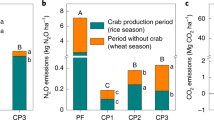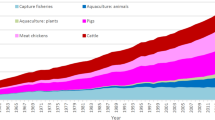Abstract
Aquaculture is a major source of greenhouse gas emissions, yet long-term spatiotemporal variations of emissions remain poorly documented. Here, we studied methane and nitrous oxide emissions from aquatic environments and carbon dioxide emissions from fishing vessel fuel combustion of the China’s aquaculture industry between 2000 and 2020. Results show that greenhouse gas emissions from aquaculture increased from 183.1 to 203.3 Tg of CO2-equivalent from 2000 to 2020, exhibiting a wave growth pattern. Spatiotemporal patterns show that China’s top six provincial greenhouse gas emitters, namely Hubei, Jiangsu, Zhejiang, Anhui, Hunan, and Sichuan, collectively released 98.5 Tg, accounting for 45% of the country’s total aquacultural greenhouse gas emissions. Also, we find that six provinces, namely Hubei, Anhui, Hunan, Jilin, Liaoning, and Jiangxi, present high emission growth rates ranging from 46.9 to 154% between 2000 and 2020. Moreover, methane emissions from extensive and semi-intensive freshwater aquaculture production contribute 90.7% of China’s total aquaculture greenhouse gas emissions, thus dominating the sector’s greenhouse gas emissions. Our findings highlight the need to reduce emissions in provinces with high aquaculture greenhouse gas emissions or growth rates, with a focus on methane reduction from freshwater aquaculture.




Similar content being viewed by others
References
Ding WX, Yuan JJ, Liu DY, Chen ZM (2020) CH4 and N2O emissions from freshwater aquaculture. J Agro-Environ Sci 39(4):749–761 (in Chinese with English Abstract)
Dong B, Xi Y, Cui YX, Peng SS (2023) Quantifying methane emissions from aquaculture ponds in China. Environ Sci Technol 57(4):1576–1583
FAO (2022) The state of world fisheries and aquaculture. Food and Agricultural Organization of the United Nations, Rome
Feng JS (2014) Sturgeon intensive net tank culture technology. Agric Sci Technol Inf 16 (in Chinese with English Abstract)
Fisheries Administration, Ministry of Agriculture and Rural Affairs (2020) National Fishery Economic Statistics Bulletin 2020 (in Chinese)
Jiang QT, Nishan B, Markus P, Xu ZC (2022) Environmental sustainability and footprints of global aquaculture. Resour Conserv Recycl 180:106183
Jin SQ, Chen J (2012) Research on direct energy consumption and carbon emissions of aquaculture in China. Chin Fish Econ 30(01) (in Chinese with English Abstract).
Liu H, Che X (2010) A preliminary study on estimating CO2 emissions from aquaculture in China. Southern Fisheries. 6(04):77–80 (in Chinese with English Abstract)
Li X, Liu ZF, Zhao MJ, Xu LJ, Sun HW (2022) Carbon peak and carbon neutralization goals and realization paths of the aquaculture and fishing industry in China. J Agric Sci Technol 24(11):13–26 (in Chinese with English Abstract)
Liu JW, Liu H, Zhuang BL, Qu R (2019) Progress in research on greenhouse gas emissions from freshwater pond aquaculture. Fish Mod 46(06):14–21 (in Chinese with English Abstract)
Luo GZ, Shao LN (2019) Advances in research on N2O emissions from aquaculture activities. Chin Fish Sci 26(03):604–619 (in Chinese with English Abstract)
Ma YC, Sun LY, Liu CY, Yang B, Wang FY, Zhou W (2018) Methane emission from two typical aquaculture ponds in Lake Tai. Ecol Environ Sci 27(07):1269–1275 (in Chinese with English Abstract)
Ministry of Agriculture and Rural Affairs (2020) Notice on the implementation of the “Five Actions” for green and healthy aquaculture in 2020
Ministry of Agriculture of the PRC (2016) Guidance from the Ministry of agriculture on accelerating the transformation and restructuring of the fisheries industry no. 1
Olmer N, Comer B, Roy B, Mao XL, Rutherford D (2017) Greenhouse gas emissions from global shipping, 2013–2015. In: International Council on Clean Transportation: Washington
Xu CJ, Su GH, Zhao KS, Xu XQ, Li ZQ, Hu Q, Xue Y, Xu J (2022) Current status of greenhouse gas emissions from aquaculture in China. Water Biol Secur 1(3):100041
Xu CJ, Su GH, Zhao KS, Wang H, Xu XQ, Li ZQ, Hu Q, Xu J (2023) Assessment of greenhouse gases emissions and intensity from Chinese marine aquaculture in the past three decades. J Environ Manag 329:117025
Yang JJ (2022) Research on the development of marine carbon sink fisheries in Liaoning. Dali Ocean Univ 09 (in Chinese with English Abstract)
Yuan JJ, Xiang J, Liu DY, Kang H, He TH, Kim S, Lin YX, Freeman C, Ding WX (2019) Rapid growth in greenhouse gas emissions from the adoption of industrial-scale aquaculture. Nat Clim Change 9:318–322
Zhang YF, Tang KW, Yang P, Yang H, Tong C, Song CC, Tan LS, Zhao GH, Zhou XD, Sun DY (2022) Assessing carbon greenhouse gas emissions from aquaculture in China based on aquaculture system types, species, environmental conditions and management practices. Agric Ecosyst Environ 338:108110
Zhang WB Ma XZ (2020) Development trends and directions of aquaculture in China since 2000. J Shanghai Ocean Univ 29 (in Chinese with English Abstract)
Zhang YN (2021) The influence of marine fishery industrial structure optimization on carbon emission efficiency: spatial econometric analysis based on coastal areas of China. Ocean Dev Manag 38(04) (in Chinese with English Abstract)
Zhao JY, Zhang M, Xiao W, Jia L, Zhang XF, Wang J, Zhang Z, Xie YH, Pu YN, Liu SD, Feng ZZ, Lee XH (2021) Large methane emission from freshwater aquaculture ponds revealed by long-term eddy covariance observation. Agric For Meteorol 308:108600
Zhao HT, Sun GQ, Wu Y, Zhao ZL, Cui ZJ, Zhao CL, Fu Z (2018) Analysis of the current situation and countermeasures of seawater factory farming in Hebei Province. Hebei Fish 12 (in Chinese with English Abstract).
Zhao MJ, Sun HW, Wang YG, Liu LT, Zhu XM, Liu ZF, Wang XH (2019) Study of the supply and consumption of aquatic products in the medium and long term based on the national nutrition demand. Chinese Fisheries Economics, 37(6):1–14 (in Chinese with English Abstract)
Zhou YE, Huang M, Tian HQ, Xu RT, Ge J, Yang XG, Liu RX, Sun YX, Pan SF, Gao QF (2021) Four decades of nitrous oxide emission from Chinese aquaculture underscores the urgency and opportunity for climate change mitigation. Environ Res Lett 16:114038
Zhou XJ, Fang JH, Shi SY, Yang L, Xie B, Huang LF (2022) Ecosystem services of ecosystem approach to mariculture: providing an unprecedented opportunity for the reform of China’s sustainable aquaculture. Front Mar Sci 9:2296–7745
Funding
This study was supported by the National Natural Science Foundation of China (41901241), State Environmental Protection Key Laboratory of Sources and Control of Air Pollution Complex (SCAPC202102).
Author information
Authors and Affiliations
Corresponding author
Ethics declarations
Conflict of interest
The authors declare no conflict of interest.
Additional information
Publisher's Note
Springer Nature remains neutral with regard to jurisdictional claims in published maps and institutional affiliations.
Supplementary Information
Below is the link to the electronic supplementary material.
Rights and permissions
Springer Nature or its licensor (e.g. a society or other partner) holds exclusive rights to this article under a publishing agreement with the author(s) or other rightsholder(s); author self-archiving of the accepted manuscript version of this article is solely governed by the terms of such publishing agreement and applicable law.
About this article
Cite this article
Feng, F., Zhuang, M. Rising greenhouse gas emissions from the China’s aquaculture industry between 2000 and 2020. Environ Chem Lett 21, 3063–3069 (2023). https://doi.org/10.1007/s10311-023-01627-w
Received:
Accepted:
Published:
Issue Date:
DOI: https://doi.org/10.1007/s10311-023-01627-w




